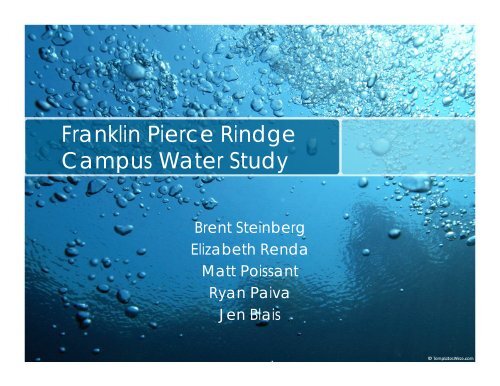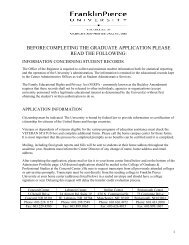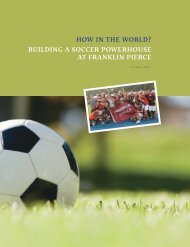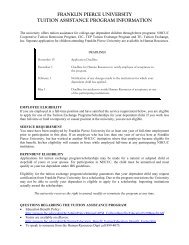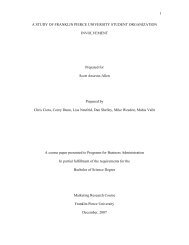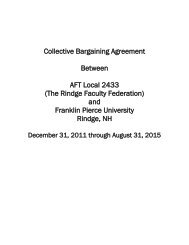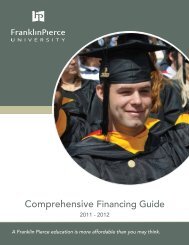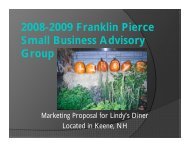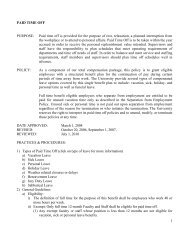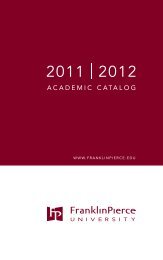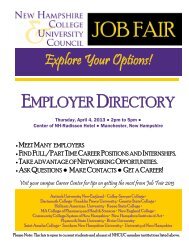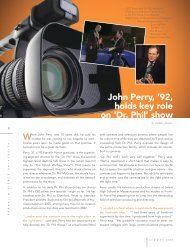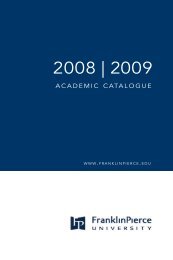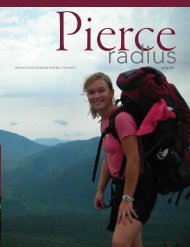Campus Water Study - eRaven - Franklin Pierce University
Campus Water Study - eRaven - Franklin Pierce University
Campus Water Study - eRaven - Franklin Pierce University
- No tags were found...
Create successful ePaper yourself
Turn your PDF publications into a flip-book with our unique Google optimized e-Paper software.
<strong>Franklin</strong> <strong>Pierce</strong> Rindge<strong>Campus</strong> <strong>Water</strong> <strong>Study</strong>Brent SteinbergElizabeth RendaMatt PoissantRyan PaivaJen Blais
Introduction• Founded by Frank S. DiPietro in 1962, <strong>Franklin</strong> <strong>Pierce</strong>of New Hampshire is a four-year, liberal artsuniversity located in Rindge, New Hampshire.• The main campus which is situated on more than1,200 acres of woodland, fields, and waterfront,currently enrolls approximately 1,500 students withthe majority of them living on campus.• Students who attend <strong>Franklin</strong> <strong>Pierce</strong> <strong>University</strong> havetolerated unsafe drinking water for too long. It isnecessary and encouraged that students purchasedrinking water bottles, five-gallon water dispensers, orfilters to provide safe, clean, and tasteful drinkingwater.
Introduction• The purpose of this research is to find out the mostenvironmentally friendly and economical way tosupply quality drinking water to the students andfaculty of the <strong>Franklin</strong> <strong>Pierce</strong> community.• It has been proven that the amount of water bottlesthrown away each year creates extremely largeamounts of waste.• Therefore, the research team wants to find the bestalternative to providing quality drinking water oncampus so <strong>Franklin</strong> <strong>Pierce</strong> <strong>University</strong> can do its partwith the ever important green movement.
Problem StatementResearch is necessary to determine the mostenvironmental and economical strategy todistribute quality drinking water to the Rindge<strong>Franklin</strong> <strong>Pierce</strong> community.
Research Objectives• Determine the amount of waste produced from waterbottles on campus.• Determine the amount of financial resources usedfrom water bottles on campus.• Determine the most economical drinking wateralternative for <strong>Franklin</strong> <strong>Pierce</strong> students.• Determine what drinking water, either bottled orfiltrated, is preferred.• Determine how students would like to have analternative water source distributed.
Literature Review• Americans used 50 billion plastic water bottles in2006 with only 23% of them being recycled. (1)• It takes 24 million gallons of oil to produce 1billion water bottles. (1)• Filtered water requires no more energy than isalready used to propel water through a plumbingsystem. (2)• <strong>Water</strong> filters remove more contaminants than anyother purification method, also they canselectively retain healthy trace minerals. (3)• 25% of bottled water is in fact tap water. (4)
MethodologyDefinition of Population• The population of <strong>Franklin</strong> <strong>Pierce</strong> <strong>University</strong>, Rindge campusconsists of approximately 1,700 faculty, staff, and students.• The researchers chose this as the population because the research isto determine what the <strong>Franklin</strong> <strong>Pierce</strong> community prefers forconvenient, quality drinking water.Sample Size• The research team determined the sample size by realizing the needto survey all segments of the Rindge campus.• The sample size consisted of members at the Rindge campus, 80males and 70 females.• The research team also divided the sample by status at the universityinto 30 students from each class (Freshman, Sophomore, Junior,Senior) and 30 faculty and staff.
Methodology• The research team used the non-probability conveniencesampling method when handing out surveys. Theresearchers handed out the questionnaires to students,faculty, and staff in the offices and dormitories• The researchers also used a quota sampling method basedon gender and class standing to get an equal response fromeach class, as well as both genders.• For the team collection method, each group membersurveyed a segment of the population. Each researchertargeted 15 males and 15 females from each of theirrespective segments.
Assumptions and LimitationsAssumptions• As the surveys were distributed theassumptions were that everyone answeredthese surveys truthfully, and accurately.Limitations• The researchers found that time and therelatively small sample size to be limitations tothe research process.
Survey Question # 1Do you use plastic water bottles?
Survey Question # 3If you don’t recycle how manybottles do you estimate you throwaway a month?• Mean: 20• Range: 100• 34% of people surveyed throw away 30 ormore bottles a month.
Survey Question #5How much do you estimate youspend on bottled water a month?
Survey Question #6What do you perceive as being themost economical alternative fordrinking tap water?
Survey Question #7What type of water do you preferto drink?
Survey Question #8What would be the most convenientway to get quality drinking wateron campus?
Survey Question #9What type of quality drinking waterdoes the university currently providewhere you live or work?
Survey Question #10Would you be willing to pay extramoney for quality drinking waterat the <strong>University</strong>?
Survey Question #11If yes, how much would you bewilling to pay per semester?• The average respondent was willingto pay $26.00 for quality drinkingwater.
Cross Tabulations• What is your status and do you recycle?– Freshman: 8 out of 30 responded yes– Sophomores: 16 out of 30 responded yes– Juniors: 18 out of 30 responded yes– Seniors: 9 out of 30 responded yes– Staff: 11 out of 15 responded yes– Faculty: 11 out of 15 responded yes
Cross Tabulations• What is your gender and wouldyou be willing to pay extra moneyfor quality drinking water?• Female: 37 out of 70 responded yes• Male: 27 out of 80 responded yes
Discussion• As discovered in our literature review, FPU students,similarly to the general public, discard a significantamount of water bottles as trash.• The literature suggests that other universities supplyreusable water bottles and water bottle refill stations.• As found in our study, our respondents felt thatfiltration was the most economical andenvironmentally friendly way to supply water, whichwas proven to be true by our literature review.
Recommendations• We recommend that the school use an improved centralfiltration system for the entire campus, or use individualfilters for each residence and other campus buildings• We also feel that the school should implement atemporary solution to the present water problem, byoffering five gallon water coolers in residences andoffices or by providing reusable bottles with waterfountain refill stations.• Use one of the natural springs on the school’s property tosupply clean water.• We also recommend that the school should provide morerecycling stations.
Conclusion• The water in the southwestern part of NewHampshire has a high fluoride and ironcontent, tainting the color of the water as wellas the taste.• According to our results, the majority ofstudents do not drink FPU’s tap water. Thisresults in the typical student throwing away(not recycling) an average of 20 water bottles amonth.
Conclusion• The data that we have collected proves thatthere is a problem with the water quality.• 53% of the FPU community believes thatwater filtration is the most economicalalternative to the current tap water.• Out of 110 people who throw bottles away, 34people throw away 30 or more bottles a month;creating a large amount of waste.
References1. « One Earth One Bottle Campaign; Southern NewHampshire <strong>University</strong>. » Southern New Hampshire<strong>University</strong> (SNHU). Web. 08 Oct. 2009.2. (2008). <strong>Water</strong> Wars: Bottled or Tap? Mother Earth News,(226), 19. .3. « water Treatment Alternative – Filtration. » All About<strong>Water</strong> – Read, Learn, Know about <strong>Water</strong>. 8 Oct. 20094. Sarafa, Farrah. « <strong>Water</strong>: The Myth of Bottled. » Green andSave. 5 Oct. 2009. Web. 7 Oct. 2009.


